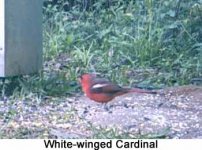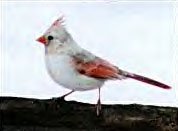-
Welcome to BirdForum, the internet's largest birding community with thousands of members from all over the world. The forums are dedicated to wild birds, birding, binoculars and equipment and all that goes with it.
Please register for an account to take part in the discussions in the forum, post your pictures in the gallery and more.
You are using an out of date browser. It may not display this or other websites correctly.
You should upgrade or use an alternative browser.
You should upgrade or use an alternative browser.
White-winged Cardinal (1 Viewer)
- Thread starter wroughtiron
- Start date
More options
Who Replied?wroughtiron
Patriotic User
The bird I have pictured in my original post has identical white wingbars on both wings and is a White-winged Cardinal.
Here is a picture of a leucistic Northern Cardinal for comparison. Leucism is partial albinism, there is no such thing as "partial leucism" in a bird. Leucism in itself means "partial albinism" and any "partial albinism" is considered leucistic. Please feel free to contact the Cornell Lab of Ornithology at 1-800-843-2473 for their definition of leucism.
Here is a picture of a leucistic Northern Cardinal for comparison. Leucism is partial albinism, there is no such thing as "partial leucism" in a bird. Leucism in itself means "partial albinism" and any "partial albinism" is considered leucistic. Please feel free to contact the Cornell Lab of Ornithology at 1-800-843-2473 for their definition of leucism.
Attachments
Last edited:
Katy Penland
Well-known member
Do you have a scientific name for your White-winged Cardinal? It's certainly not in any of the bazillion birds of North America books I have. I have to agree with those already posted who said this is just a Northern Cardinal with leucistic feathers in the wing(s).
Leucism is a lack of pigmentation in the feathers; albinism is a lack of pigmentation in the soft tissues (eyes, skin, etc.). Leucism can most certainly be "partial" as it can mean anything from a single lighter-than-normal/white feather to patches scattered all over the bird to ALL feathers being lighter-than-normal/white (with skin, eyes, etc., still colored normally). Leucism can also appear in symmetrical patterns on the bird.
Many birders also tend to call any bird with any white on it a "partial albino," and it's become a commonly accepted term even if technically it isn't scientifically accurate.
Leucism is a lack of pigmentation in the feathers; albinism is a lack of pigmentation in the soft tissues (eyes, skin, etc.). Leucism can most certainly be "partial" as it can mean anything from a single lighter-than-normal/white feather to patches scattered all over the bird to ALL feathers being lighter-than-normal/white (with skin, eyes, etc., still colored normally). Leucism can also appear in symmetrical patterns on the bird.
Many birders also tend to call any bird with any white on it a "partial albino," and it's become a commonly accepted term even if technically it isn't scientifically accurate.
baccalynnwv
Well-known member
I as well have a cardinal with one white feather on his wing that visits my feeders. 
wroughtiron
Patriotic User
An albino bird lacks all pigments while a leucistic bird has a reduced intensity of pigmentation. If a bird has a reduced intensity of pigmentation over part of its body, then it is leucistic. If a bird has reduced intensity of pigmentation over most of its body, then it is still leucistic. In summary, any reduced intensity of pigmentation over part of a bird, whether major or minor, would make that bird a leucistic bird. Therefore, to say a bird is "partial leucistic" is incorrect. The correct description would be to say a bird has major or minor reduced intensity of pigmentation.
You wouldn't have a bird that is "partially pregnant" no more than you would have a bird that is a "partial leucistic." A bird is either leucistic or not leucistic. You can however, have a bird who has more or less areas effected by leucism.
Also, leucism can very well affect more than feathers. So to say leucism is a lack of pigmentation in the feathers is incorrect. I have seen birds that have lack of pigmentation in legs and beaks as well. A bird that has lack of pigmentation in legs, beaks, etc., is not a "partial albino," but a "leucistic bird."
As always, I do enjoy reading the replies from the good people at the BirdForum. I wish everyone the best of luck in their birding ventures this year.
You wouldn't have a bird that is "partially pregnant" no more than you would have a bird that is a "partial leucistic." A bird is either leucistic or not leucistic. You can however, have a bird who has more or less areas effected by leucism.
Also, leucism can very well affect more than feathers. So to say leucism is a lack of pigmentation in the feathers is incorrect. I have seen birds that have lack of pigmentation in legs and beaks as well. A bird that has lack of pigmentation in legs, beaks, etc., is not a "partial albino," but a "leucistic bird."
As always, I do enjoy reading the replies from the good people at the BirdForum. I wish everyone the best of luck in their birding ventures this year.
Rasmus Boegh
BF member
wroughtiron said:Therefore, to say a bird is "partial leucistic" is incorrect.
While used infrequently, both complete and partial leucism actually are used in scientific circles. Calling leucism complete has been used for birds (mammals, etc.) where everything but the soft parts are paler. "Partial leucism" is used about anything where there only are patches that are paler. Indeed, doing a google search for partial leucism will give various results, several of which are articles from scientific papers. So, while used infrequently, they are not incorrect.
Last edited:
wroughtiron
Patriotic User
As always, I enjoy reading replies from everyone. I do believe that "partial leucism" is an acceptable form of slang, however, it is scientifically incorrect.
Best of luck to everyone in your birding ventures.
Best of luck to everyone in your birding ventures.
Last edited:

And what did you find out about your "white-winged cardinal"?wroughtiron said:As always, I enjoy reading replies from everyone. I do believe that "partial leucism" is an acceptable form of slang, however, it is scientifically incorrect.
Best of luck to everyone in your birding ventures.
GreatHornedOwl
Grumpy Armchair Birder
wroughtiron said:Here is a picture of a White-winged Cardinal caught on a motion sensored feeder cam. It was eating cracked corn off the ground. The picture was taken in Tallahassee, Florida on May 11, 2005.
Now I know Cardinals only from pictures, but first thing that crossed my mind is that this one oddly looked like a hybrid Northern cardinal X (European) Bullfinch (Pyrrhula pyrrhula)... Perhaps an escaped cross-breed bird ?
... But I could have had too much B
GreatHornedOwl said:Now I know Cardinals only from pictures, but first thing that crossed my mind is that this one oddly looked like a hybrid Northern cardinal X (European) Bullfinch (Pyrrhula pyrrhula)... Perhaps an escaped cross-breed bird ?
... But I could have had too much Btoday ...
Very interesting thought...I haven't seen that many Bullfinches, but you are right. THe shape of the bird seems off for a cardinal and the wing patches seem very bullfinchy....hmmmmm.
crispycreme
Well-known member
I don't see any crest at all.
crispycreme said:I don't see any crest at all.
Sometimes they flatten their crests back, but I agree that this one doesn't look quite right.
crispycreme
Well-known member
Sometimes they flatten their crests back
But they can't make them disappear, unlike other birds with less pronounced crests. At least I've never seen it done. When they do flatten them, the crest simply points backward, and is more parallel with the ground; but it's still clearly visible. I know this is a rather grainy pic, but you'd think you'd still see some bit of it (i.e. the background doesn't appear capable of camoflauging or obstructing it), and the fact that top of the head is in pretty good focus shows to me that this bird is absolutely crest-less.
I wonder if this is a Cardinal at all: leucistic, hybridized or whatever.
Katy Penland
Well-known member
Y'know, Matt, you may be onto something there. I sucked this image into Photoshop to try to desaturate some of the reddish color (notice how pinkish the ground is?), and in playing with the color levels, guess what never changed color? The beak -- it appears to be flesh- or light-colored. It isn't red at all which it would have to be for an adult Northern Cardinal (and a juvie wouldn't have the deep red plumage yet; anyway, juvie beaks are black).
Rasmus Boegh
BF member
crispycreme said:I wonder if this is a Cardinal at all: leucistic, hybridized or whatever.
You certainly could be right. However, I can't think of anything on a World-wide basis that should look like this. Unless I managed to forget something this distinctive the idea of some strange hybrid or another species (whichever that would be) with plumage abnormalities seem likely.
Users who are viewing this thread
Total: 2 (members: 0, guests: 2)





